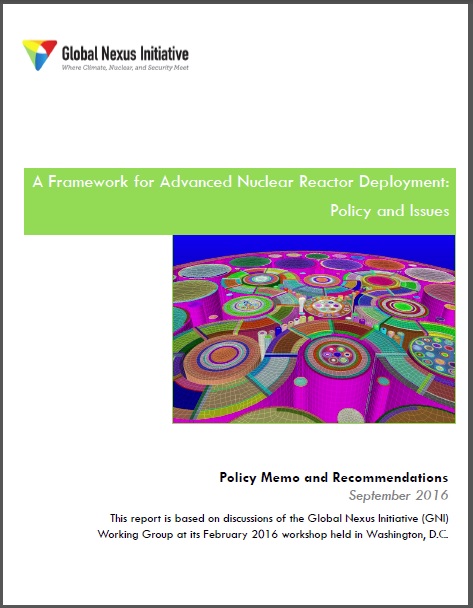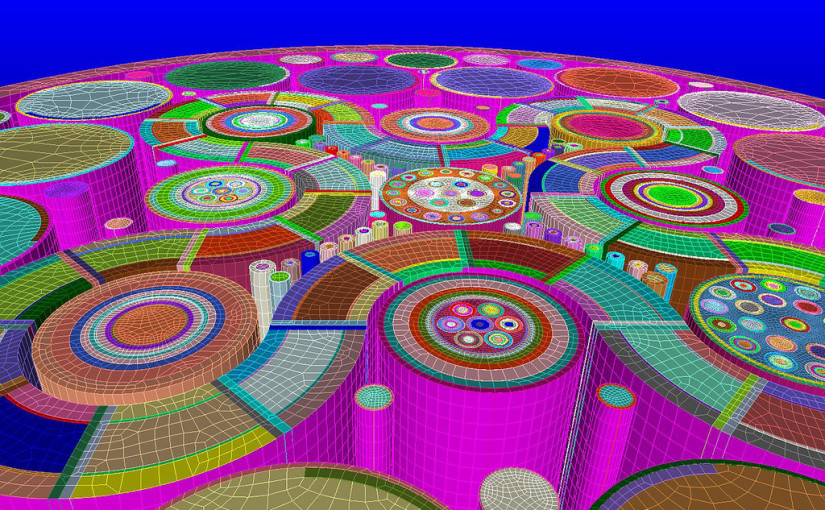
A Framework for Advanced Nuclear Reactor Development
Findings and Recommendations
The following findings and recommendations are based on the Global Nexus Initiative’s February 2016 workshop on Next Generation Nuclear Power: Value and Challenges of Transitioning to Advanced Technologies.
FINDING I: Meeting Climate Goals
In order to meet the Paris Climate Change Agreement, analysis by the Intergovernmental Panel on Climate Change (IPCC) and others indicates that there will need to be a near-zero carbon electricity system soon after mid-century. Reductions of this magnitude require significant and rapid technological advances including in the four key elements of a climate change response strategy – energy efficiency, renewable energy, CCS, and nuclear power.
At present, nuclear power is making a very significant contribution to the Paris goal and most studies by the IPCC and others suggest that nuclear capacity will need to grow.However, the existing nuclear reactor fleet is facing a potential cliff of retirements in mid-century. Fifty-three percent of the current global reactor fleet is over 30 years old, and by 2050, those plants will be over 60 years old. It is estimated that by 2050, 357 of the current 448 plants could be retired. Yet, very few nations have included nuclear power as a part of their approach to reducing carbon emissions as outlined in their national commitments at the Paris meeting.
Recommendations
- While a significant number of large-scale light water nuclear reactors are under construction or contemplated, primarily in developing countries, next generation nuclear reactors may offer a promising technological and economic solution to the looming decline in the existing power reactor fleet in developed countries. However, there are still many uncertainties associated with these reactors that need to be addressed including economic, safety, safeguards and security considerations. At present, many of the advanced reactor designs are at the conceptual stage, though many of the concepts have been previously demonstrated in some form. An acceleration toward the demonstration phase for these reactors is required if they are to meet the clean energy needs identified in the Paris agreement.
- As next generation reactor deployment is pursued it must be with a clear understanding of the urgency imposed by aggressive climate objectives. There are carbon reduction benefits from both the existing light water reactor fleet and future advanced reactors. An unacceptable outcome, in light of the Paris Agreement, is to allow carbon emissions to rise if nuclear power’s zero emissions are reduced through retirements and alternative technologies are not adequate to compensate, causing increased reliance on higher carbon emitting sources of energy.
FINDING II: Demonstrating the Technology
At present, there are multiple advanced reactor designs being pursued by a variety of private sector entities and governments. The objective of these investments is commercial deployment of the reactors and as a result there is considerable focus on identifying the size and composition of the market for these technologies. However, it is a multi-billion dollar investment to develop and commercialize a single nuclear reactor design. There is an estimated $1.3 billion in private funds that have been invested to date in various concepts, a significant amount but well short of the amount required for full demonstration. However, this investment may exit or the additional investment necessary may not be realized if the technologies cannot be successfully demonstrated or if a “business as usual” approach from the governments and regulators to this class of reactors serves to impede timely development and deployment.
Recommendations
- The international market for advanced reactors needs to be realistically assessed and potential purchasers and operators need to identify the required reactor characteristics, costs and the timeframe on which deployment is needed.
- To achieve timely deployment of next generation reactors, it essential that research and development test beds and demonstration platforms be created in the near term. This will assist in effectively addressing the issues associated with reactor licensing, affordability, risk management, safety, safeguards, security and waste management. It also will push forward the most promising designs and support continued innovation. Moving to this stage will require political will and financial support beyond the short term. The number of advanced reactor technologies will certainly be reduced as the demonstration phase proceeds, and as that occurs there is value in narrowing the diversity of designs and harmonizing the licensing requirements for these reactors across borders to the extent possible. This could allow for the sale of fleets of plants in a manner similar to jetliners and avoid the problem of reactors having unique characteristics or requiring redesigns in each country.
- Unlike in the early nuclear era, the prototyping and demonstration of advanced reactors are unlikely to be wholly government financed, except in state dominated economies. In free market economies, advanced reactor designs generally will be much more dependent on private financing. However, the effort may prove to be too expensive and risky for the private sector to shoulder alone. Therefore, the best path forward is a cost-sharing private-public partnership through the demonstration phase. Governments can demonstrate political encouragement by providing facilities, expertise and possibly some financial support and the private sector can contribute to the technology demonstration, assess the most promising reactor concepts, and drive the process according to market demands.

FINDING III: Accelerating Licensing
A vital need for non-light water advanced reactors is the use of a phased and predictable licensing process. As the U.S. Nuclear Regulatory Commission (NRC) is considered to be the model for nuclear regulatory development, a significant part of this licensing burden may fall on the U.S. The current NRC process presents two major barriers to the licensing of next generation reactor technologies. The first is that existing regulations are designed for light water reactors. The second is that the regulatory process is not designed or sequenced to synchronize with the funding challenges of smaller startup companies, which rely on private finance. The combination of these two characteristics could significantly discourage continued private investment in advanced reactors and deter the movement of these technologies to demonstration and ultimately deployment.
The existing regulatory structure would benefit from the establishment of a more technology inclusive, risk-informed, and performance-based framework for advanced reactor licensing. In the U.S., the NRC is willing to provide early guidance through technical and topical reports and documents as well as work with vendors to provide early guidance on their designs. In addition, establishing meaningful regulatory decision milestones through a staged process could be helpful for advanced reactor designers when seeking additional funding. Such milestones, providing incremental assurance of the ability to license, would benefit all stakeholders in more efficiently managing the investment of human capital and financial resources.
The U.S. government is cognizant of these challenges and is working through the legislative and executive branches to address them, although progress has been slower than needed and these processes have not yet had a meaningful impact on many of these issues. However, other countries are not dependent on U.S. practices and some, including Russia and China, plan to move forward rapidly with their preferred advanced technologies and licensing procedures. This could undercut high technical standards, skew market choices, and have other impacts on the global nuclear industry. Much like issues associated with technology development, there is a persuasive argument to be made in favor of harmonizing international regulations for advanced reactors to prevent fragmentation.
Recommendations
- The licensing process in the U.S. for next generation reactors must be advanced if these technologies are to be a realistic and deployable option that will meet international climate and energy objectives. The NRC should engage with technology innovators in a staged process and offer meaningful and useful feedback on regulatory matters as the design is being developed and demonstrated. This will encourage continued private investment and allow for the down-selection of the most promising and mature technologies.
- Equally important is the use of international regulatory fora, such as the Organization for Economic Cooperation and Development (OECD) Nuclear Energy Agency’s (NEA) Multinational Design and Evaluation Programme (MDEP), for the development of international licensing standards for advanced reactors. Pursuing a harmonized, consistent, and high-quality international regulatory regime would create greater international confidence that the advanced reactor class has collectively addressed concerns about safety, security and safeguards protections.
FINDING IV: Enhancing Safety and Security
Creating a high level of public confidence in next generation reactor technology will be essential to its commercial success. International confidence in nuclear power has been adversely affected by the nuclear accidents at Three Mile Island, Chernobyl and most recently Fukushima. In addition, there is significant public awareness of the potential nuclear weapons proliferation opportunities presented by commercial nuclear technologies. Further, the nihilistic nature of 21st century terrorism has underscored that there are few – if any – barriers that dedicated extremists will not try to cross and that nuclear terrorism is a real threat. The intersection of next generation reactors and heightened concern about nuclear dangers requires that any new technology provide the most advanced levels of safety, safeguards and security. Effectively addressing these three issues will be essential for creating the public confidence necessary for the deployment of advanced reactors outside of state-run energy systems.
Recommendations
There are three steps related to security and non-proliferation that advanced reactor designers and the international community should be taking as concepts move toward testing, demonstration and deployment. These issues should not be sacrificed to other reactor considerations.
- High levels of safety, safeguards and security should be incorporated into the initial reactor designs. These features should be rigorously tested against realistic and challenging scenarios to further strengthen these systems.
- The fuel cycle for any advanced reactor should minimize the opportunities for proliferation. In particular, the international community should oppose advanced reactor fuel cycles that are designed for the specific purpose of breeding a surplus of plutonium for future use in nuclear reactors. It also should oppose the stockpiling of separated plutonium and the use of uranium-235 fuel enrichments that exceed 20 percent.
- In tandem with the development of next generation reactor concepts, the international community should acknowledge and address the significant gaps that exist in the global nuclear security regime by strengthening the international legal framework.

